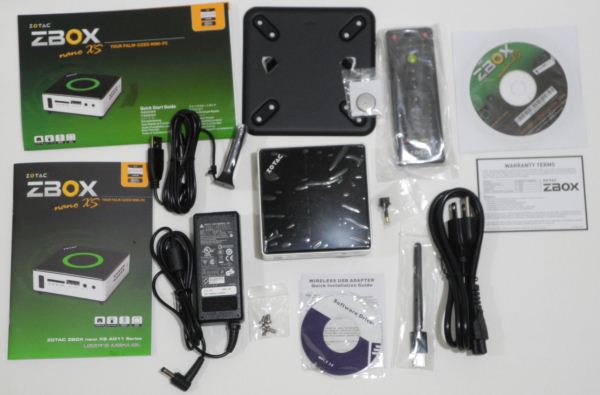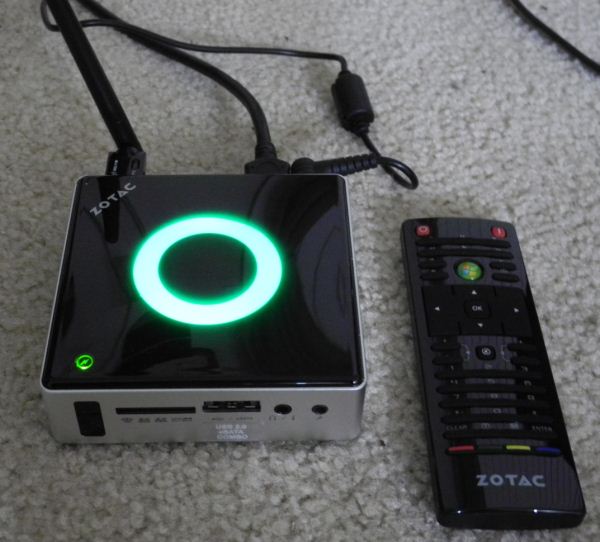Zotac ZBOX Nano XS AD11 Plus: Redefining the Small Form Factor PC
by Ganesh T S on April 11, 2012 5:30 PM EST- Posted in
- Home Theater
- ZOTAC
- Fusion
- HTPC
The ZBOX comes in a small package, about the size one would expect for a mid-range graphics card. In making up for the small size of the PC, Zotac has put in all sorts of add-on peripherals into the package. The external PSU is rated for 65 W. Apart from the main unit, the setup guides, user manuals and driver CDs, the package contained the following:
- VESA mounting plate with mounting screws
- MCE remote with 2 CR2032 batteries
- 65W (19V at 3.42A) AC - DC adaptor
- USB 2.0 based Wi-Fi (150 Mbps 802.11n) adaptor
- mini-Optical SPDIF adaptor
- USB 2.0 based extensible IR receiver (allows users to utilize the MCE remote even when the ZBOX is VESA mounted)
The main unit has a sleek rounded finish and is definitely aesthetically pleasing. The various external features of the unit have already been tabulated in the previous section. The gallery below has some photos of the unit.
The underside of the unit can be easily removed by unscrewing the four rubber risers. This gives access to the SO-DIMM as well as the mSATA slot. These are the user replaceable components. After voiding the warranty, it is possible to take a look at the other side of the board. It is quite surprising that Zotac has managed to put a fan on top of the board in such a small system. Given the space constraints, the fan is indeed short in diameter. When the system isn't being stressed much, the fan is pretty quiet. However, once the fan starts to increase the RPM, the noise dampening is not effective at all. While I would have preferred a fanless system, I do see that the target market for this PC might include people who don't understand the necessity to keep a passively cooled system in a well ventilated location.
After putting the system back together, I proceeded to boot up the system. The BIOS is quite basic, and very similar to what Ian saw in the Zotac Fusion350-A-E review except for a custom background. My main gripe with the BIOS is that there is no way for the users to set the amount of memory to keep allocated to the integrated GPU. It is set to a very inflexible 384 MB.
Once past the BIOS, I went ahead and installed Windows 7 Ultimate x64 off an USB flash drive. The install went smooth, albeit not as fast I would have wanted for a SSD based system. After installation, I found that a number of peripherals were not working (including the Ethernet and the Wi-Fi). All the drivers to be installed were on a couple of CDs, and this was a system with no optical drive. I had to hunt down another machine with an optical drive and then copy over the CD's contents onto a flash drive to proceed with the installation. After this stage, Windows took care of updating itself. It is really irritating to see companies shipping units without optical drives, but still supply drivers on a CD.
The Zotac ZBOX Nano XS AD11 Plus in Operation
(Note that the bright green ring can be turned off in the BIOS)
SSDs are meant to get things done fast on a machine. Reduction in boot time is one of the purported advantages. However, on the ZBOX unit, a Win7 SP1 clean install took around 31 seconds to boot. This is nothing to write home about. In the next section, we will take a look at the general performance metrics.
























43 Comments
View All Comments
ganeshts - Wednesday, April 11, 2012 - link
Nope, it is a standard MCE IR remote, similar to what was bundled with the Vision 3D and the CoreHT 252B.You will need a separate keyboard / mouse if you wish to do even basic browsing or navigation outside of a 10-ft UI (like XBMC)
ectoplasmosis - Wednesday, April 11, 2012 - link
The photography in this article is truly shocking.Matias - Wednesday, April 11, 2012 - link
I also noted the very poor pictures! What the hell??ganeshts - Wednesday, April 11, 2012 - link
I apologize for the poor pictures. We were running late for the NDA lift [ in fact, we missed it by a good 9 hours :( ], and had to make do with whatever I could snap in a hurry yesterday evening.adityanag - Thursday, April 12, 2012 - link
Ah I just posted a comment to this.. Well, nevermind what I said previously, these things happen :)einstein4pres - Thursday, April 12, 2012 - link
They appear to be taken with a Nikon P&S. I was curious, so I checked the exif info on the shot of the box that has an incredible amount of barrel distortion.I suggest taking the shot in the middle of your zoom range, which should help eliminate the barrel distortion, and increasing the F number (from f2.8 to ~ f8) to increase the depth of field (amount of stuff in focus). You probably need more ambient light, a flash, or a tripod to make this work.
freedom4556 - Wednesday, April 11, 2012 - link
Test HD Netflix performance in your HTPC reviews, hell, throw in Hulu Plus and HD Youtube and any other major streaming you can think of. Reason I say this is I have an E-350 based HTPC and Silverlight (Microsoft's technology that powers Netflix) doesn't properly provide hardware acceleration to HD streams coming from Netflix. This results in an unplayable single-digit FPS on my Windows 7 HTPC. Youtube works fine, Adobe's got it figured out, and on the latest drivers too. Don't have Hulu, but still FIX IT MICROSOFT. Grrrr...Musafir_86 - Thursday, April 12, 2012 - link
-Did you check that you really have Silverlight 5 installed? Windows Update only pushes Silverlight 4 as far as I could see, so you need to download and upgrade manually. Also, AFAIK, only in version 5 it have proper hardware acceleration support.Regards,
-Musafir_86.
Kakumei - Thursday, April 12, 2012 - link
microsoft removed true gpu acceleration from their to-do list for silverlight 5.You cannot watch netflix hd on netbook cpus, sorry.
Matias - Thursday, April 12, 2012 - link
I agree, cant see HD videos on Netflix using the AD10 because of lame Silverlight...